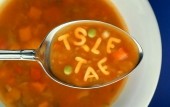Swimming in Alphabet Soup: The Language of Eating Disorders
PHP IOP NG Tube AN TPN IP AMA . . .
The first time I was hospitalized for anorexia nervosa was in June 2008. I left after 24 hours — AMA. The second time I was hospitalized for treatment my doctor informed me I would need a TPN.
I was totally clueless about the acronyms and terms. It can feel like you are swimming in a vast sea of alphabet soup when you first enter the world of eating disorders treatment. I was confused and scared when I flew to a well-known Wisconsin eating disorders hospital that summer. I was recently diagnosed with anorexia, but didn't really believe that I had a problem. I was only there because my husband and loved ones had expressed concern about my continued low weight and refusal to eat most foods and meals.
I was confused and scared when I flew to a well-known Wisconsin eating disorders hospital that summer. I was recently diagnosed with anorexia, but didn't really believe that I had a problem. I was only there because my husband and loved ones had expressed concern about my continued low weight and refusal to eat most foods and meals.
The psychiatrist there frightened me — I found her demeanor icy and uncaring, and felt like a complete failure as I tried to explain why I couldn't eat like a normal person. I decided after about twenty minutes that I could not stay there and I begged the hospital staff to release me.
The psychiatrist tried to convince me to stay, and then after telling me that I had little insight into my illness, agreed to release me AMA.
That was my first introduction to the alphabet soup of eating disorders.
Terms defined
AMA - Against Medical Advice. This basically means that the hospital or treatment center you are a patient at does not agree with your decision to leave. I later learned leaving treatment AMA can backfire on you because many insurances will refuse to pay for treatment that you have left AMA. I was fortunate in this case and my one-day stay at the Wisconsin facility was paid for.
AN - This is an abbreviation for anorexia nervosa. It is often found on blogs and other writings by people with anorexia nervosa.
Ana - This is most often used by people who consider themselves pro-ana, or pro-anorexia, meaning they promote anorexia as a lifestyle choice, not an illness. Other people will use the term Ana as a name for their illness of anorexia.
ED - Eating disorder or eating disorders. This acronym can be neutral and used just for abbreviation. However, many people with eating disorders will refer to their illness (whether anorexia nervosa, bulimia nervosa, EDNOS, or binge eating disorder) as ED and use the initials as a personification of their illness, i.e. "I am going to beat ED." There are many books about eating disorders that use ED in this manner.
EDNOS - Eating Disorder Not Otherwise Specified. This is a diagnosis given when a patient doesn't meet the criteria for anorexia or bulimia. Currently binge eating disorder is not a diagnosis; however, this most likely will change with the release of the DSM-V (Diagnostic and Statistical Manual).
IP - Inpatient hospitalization. This is treatment in a psychiatric setting where the patient stays 24/7. Treatment in an IP setting varies depending upon the hospital. Some hospitals have a separate unit for eating disorders, while other hospitals do not and ED patients often participate in some treatment modalities (such as groups) with patients who have depression, anxiety, schizophrenia and other mental illnesses.
IOP - Intensive Outpatient. IOP, also known as Day Treatment, is treatment in which the patients typically attend three to five days weekly and then leave for the day. Some IOPs provide housing, while others do not and the patients return to their homes each day.
NG Tube - Nasogastric tube. A NG tube is inserted through the nose and into the stomach for the purposes of feeding patients, including those with eating disorders who are nutritionally compromised.
TPN - Total Parenteral Nutrition. A TPN is inserted through a vein in your arm and feeds a person intravenously.
Experiences with ED Alphabet soup
I have had both a TPN and a NG tube. I was given TPN for ten days in August 2008 after I was hospitalized because I had been restricting for so long and was very nutritionally compromised. The TPN tube slipped in easily, and the only problem was that I could not take a shower because the risk for infection is high.
I didn't find the NG tube experience as easy. The technician had difficulty inserting the tube, and I happen to have a really strong gag reflex, meaning that I threw up three times before it could be inserted. It hurt and I was constantly plugged up and had a runny nose because the body naturally tries remove this foreign object.
It has been almost one year since I have been in any type of treatment center, and I hope to leave all these terms behind as I continue to maintain my healthy goal weight. For me, the best word in the alphabet soup of EDs is recovery.
For more information about terms, diagnoses, and personal stories from people struggling with eating disorders, visit the HealthyPlace Eating Disorders Homepage.
APA Reference
Gambrel, A.
(2011, June 10). Swimming in Alphabet Soup: The Language of Eating Disorders, HealthyPlace. Retrieved
on 2025, December 28 from https://www.healthyplace.com/blogs/survivinged/2011/06/swimming-in-alphabet-soup-the-language-of-eating-disorders